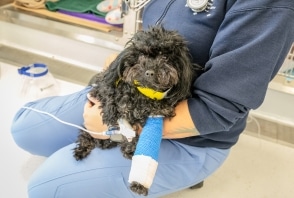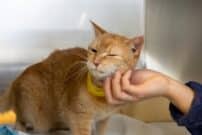Everyday Medicine: Blood Pressure in Dogs and Cats

Everyday Medicine: Blood Pressure in Dogs and Cats
Everyday Medicine is an intermittent series of blog posts highlighting tests, treatments and procedures common in daily Animal Medical Center practice. Some past examples of this type of blog post include “The Highs and Lows of Blood Sugar” and “The Third Eyelid.” Today’s post focuses on blood pressure.
Blood Pressure Definition
Everyone has had their blood pressure taken at the doctor’s office and we all know high blood pressure, or hypertension, is bad. But what does that Velcro covered cuff really measure? The cuff measures the pressure the circulating blood exerts on the walls of the blood vessel. When your blood pressure is taken, the nurse reports a number over a number. The top number (systolic blood pressure) is the pressure on the vessel walls when the heart pumps and the diastolic blood pressure or bottom number is the pressure when the heart relaxes. The blood pressure monitors veterinarians use in the clinic for dogs and cats usually measure only the top number, or systolic pressure.
Causes of High Blood Pressure in Dogs and Cats
The most common cause of hypertension in both dogs and cats is chronic kidney disease. The International Renal Interest Society recommends all pets with kidney disease have their blood pressure measured as part of a clinical evaluation. Hypertensive pets should be treated with antihypertensive agents to protect their eyes, heart, brain and kidneys from damage due to high blood pressure.
Hyperthyroidism is another known cause of hypertension, most commonly in cats. Successful treatment of hyperthyroidism typically resolves the hypertension without administration of antihypertensive medications.
Causes of Low Blood Pressure in Dogs and Cats
Low blood pressure is a common problem in AMC’s ER patients. Many ER patients have fluid loss. For example, vomiting and diarrhea-producing dehydration decrease the amount of fluid in the blood vessels, as does hemorrhage. Both dehydration and hemorrhage can result in low blood pressure. A severe systemic infection often leads to low blood pressure through a complex series of physiologic events. Since so many emergency situations lead to low blood pressure, an intravenous catheter and administration of intravenous fluids is typically one of the first emergency therapies administered in an animal ER.
If your pet has recently been anesthetized, he probably has a clipped spot on one of his front legs. That spot identifies the location of an intravenous catheter placement. General anesthesia decreases blood pressure. Veterinarians monitor blood pressure during anesthesia and give intravenous fluids during anesthetic procedures to help maintain blood pressure within a normal range.
Pets with hypertension have frequent blood pressure measurements taken while their veterinarians adjust medications to normalize blood pressure. Blood pressure medication must be titrated to the proper amount to prevent low blood pressure or hypotension. Hypotension makes pets weak and may negatively impact their kidney function.
If your pet is making a trip to the veterinarian soon, don’t be surprised if one of the veterinary technicians brings out a petite blood pressure cuff and places it around your pet’s wrist, since blood pressure is an important medical test.



































